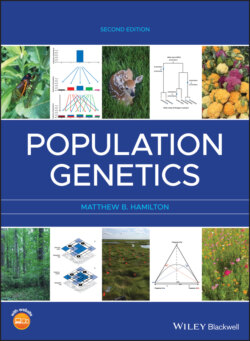Читать книгу Population Genetics - Matthew B. Hamilton - Страница 15
Inductive and deductive reasoning
ОглавлениеPopulation genetics employs both inductive and deductive reasoning in an effort to understand the biological processes operating in actual populations as well as to elucidate the general processes that cause population genetic phenomena. The inductive approach to population genetics involves assembling measures of genetic variation (parameter estimates) from various populations to build up evidence that can be used to identify the underlying processes that produced the observed patterns. This approach is logically identical to that used by Isaac Newton, who used knowledge of how objects fall to the surface of the Earth as well as knowledge of the movement of planets to arrive at the general principles of gravity. Application of inductive reasoning requires detailed familiarity with the various empirical data types in population genetics, such as DNA sequences, along with the results of studies that report observed patterns of genetic variation. From this accumulated empirical information, it is then possible to draw more general conclusions about the qualities and quantities of genetic variation in populations. Model organisms like D. melanogaster and Arabidopsis thaliana play a large role in population genetic conclusions reached by inductive reasoning. Because model organisms receive a large amount of scientific effort, for example, to completely sequence and annotate their genomes, a great deal of available genetic data are accumulated for these species. Based on this evidence, many inferences have been made about population genetic processes. Although model organisms are very rich sources of empirical information, the number of species is limited by definition so that any generalizations may not apply universally to all species.
Deductive reasoning: Using general principles to reach conclusions about specific instances.
Inductive reasoning: Utilizing the knowledge of specific instances or cases to arrive at general principles.
The study of population genetics can also be approached using deductive reasoning. The actions of general processes such as genetic drift, mutation, and natural selection are represented by parameters in the mathematical equations that make up population genetic models. These models can then be used to make predictions about the quantity of genetic variation and patterns of genetic variation in space and time. Such population genetic models make general predictions about things like rates of change in allele frequency, the eventual equilibrium of allele or genotype frequencies, and the net outcome of several processes operating at the same time. These predictions are very general in that they apply to any population of any species since the predictions arose from general principles in the first place. At the same time, such general predictions may not be directly applicable to a specific population because the general principles and assumptions used to make the prediction are not specific enough to match an actual population.
Historically, the field of population genetics has developed from an interplay between arguments and evidence developed using both inductive and deductive reasoning approaches. Nonetheless, most of the major ideas in population genetics can be first approached with deductive reasoning by learning and understanding the expectations that arise from the principles of Mendelian heredity. This book stresses on the process of deductive reasoning to arrive at these fundamental predictions. Empirical evidence related to expectations is included to illustrate predictions and to demonstrate hypothesis tests that result from expectations. Because the body of empirical results in population genetics is very large, readers should resist the temptation to generalize too much from the limited number of empirical studies that are presented. Detailed reviews of particular areas of population genetics, many of which are cited, are a better source for comprehensive summaries of empirical studies.
In the next chapter, we will start by building expectations for the frequencies of diploid genotypes based on the foundation of particulate inheritance: that alleles are passed unaltered from parents to offspring. There is ample support for particulate inheritance from both molecular biology, which identifies DNA as the hereditary molecule, and from allele and genotype frequencies that can be observed in actual populations. The general principle of particulate inheritance has been used to formulate a wide array of expectations about allele and genotype frequencies in populations.
